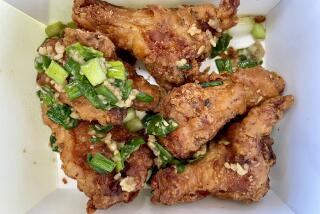A Neighborhood of Sweet Surprises in Canada : Vancouver’s Chinatown has a less touristy feel than San Francisco’s.
The air was filled with the babble of Chinese voices: earnest shoppers jostling through the open market, greeting friends and clucking at merchants over the size of bamboo shoots, the quality of cabbages, the price of shrimp.
Butchers worked behind steamy windows. The sweet aroma of almond cookies wafted from the Loong and Foong bakery.
In a corner herbalist’s shop, an elderly man in a black silk cap waited near a shelf of dried sea horses, turning the pages of a Chinese-language newspaper from back to front. Behind the counter, an herbalist--like the neighborhood pharmacist--was mixing a potion.
It could have been Kowloon.
But this was Canada--in fact, downtown Vancouver, that Pacific Northwest park-of-a-city where forests are reflected in glass-skinned skyscrapers and the world seems laced with water.
Vancouver’s Chinatown claims to be the second-largest in North America after San Francisco’s. But there are differences in mood, in mannerisms and in merchandise.
Tourists are often in the majority along San Francisco’s Grant Avenue--the “Main Street” of Chinatown. We are potential customers for embroidered silk robes and slippers, souvenir chopsticks, paper dragons, tasseled lanterns, fortune cookies, jade pendants, antique screens and packets of incense.
San Francisco’s Chinatown is a video-camera dream: fancy restaurants with upturned roofs, blocks of spiffy shops, tearooms, temples. Chinese New Year and other festivals bring wondrous parades, fireworks and costumes.
Yet every day can seem staged for visitors. Grant Avenue was the setting for lavish musical scenes in the film “Flower Drum Song” and, somehow, that stays in my mind.
Chinatown in Vancouver is more natural, more lived-in, less oriented to the tourist than to serving the needs of the city’s scattered Chinese community of perhaps 100,000.
Families come to the neighborhood around East Pender Street to eat, to shop for barbecued ducks and dried fish, farm-fresh bok choy and snow peas, and traditional medicinal cures. They come to buy Chinese books, records and videotapes. They come to attend advanced classes in tai chi at the Chinese Cultural Center or to hear folk stories told in Cantonese at the Dr. Sun Yat-Sen Garden, a full-scale classical garden of pools and pavilions that was constructed with tiles, lattice windows and huge, pocked limestone boulders shipped from China.
Vancouver’s Chinese community seems self-sufficient. Some restaurants have English menus posted in their windows; some do not.
About 1 p.m. on a Monday in April, a friend and I realized that we were hungry for lunch and also low on Canadian cash. We turned at the Visa sign on the door of Kwangchow, an upstairs dim sum restaurant at 231-A East Pender.
The room was bustling. Every table was packed with Chinese. Shortly, a group left and we were led to a corner. Then a cart arrived, heaped with the round-lidded baskets called dim sum. A waitress lifted the top of one and asked: “You want?”
I recognized nothing, so I shook my head and pointed to the next, which contained rice mixed with cashews, shrimp and scallions. I nodded and she put it on our table.
She kept lifting other lids for my perusal. Each time I asked: “What is it?” Each time she replied, “Pork.”
“Vegetables?” I inquired with a smile. “No,” she replied.
“Chicken?”
“No.”
Finally, I pointed to what turned out to be pork dumplings. We enjoyed the savory rice and the dumplings, adding hot Chinese mustard. We finished a large pot of tea. For dessert, we pointed to a basket of three miniature custard tarts.
I had no idea what the cost would be since the check showed only categories of dishes: top, large, medium and small. We had three marks.
The man at the cash register wore a suit and seemed to be the proprietor. He looked up as I handed him the bill:
“Australian?” he asked.
“No, American,” I replied.
“Ah,” he said.
“Do you get many Americans in here?” I asked. He smiled broadly and asked, “Good lunch?”
I nodded and tried another question. Our conversation was limited by my lack of Cantonese.
The total for two turned out to be $8. I did not have the heart to use Visa.
More to Read
Sign up for The Wild
We’ll help you find the best places to hike, bike and run, as well as the perfect silent spots for meditation and yoga.
You may occasionally receive promotional content from the Los Angeles Times.






